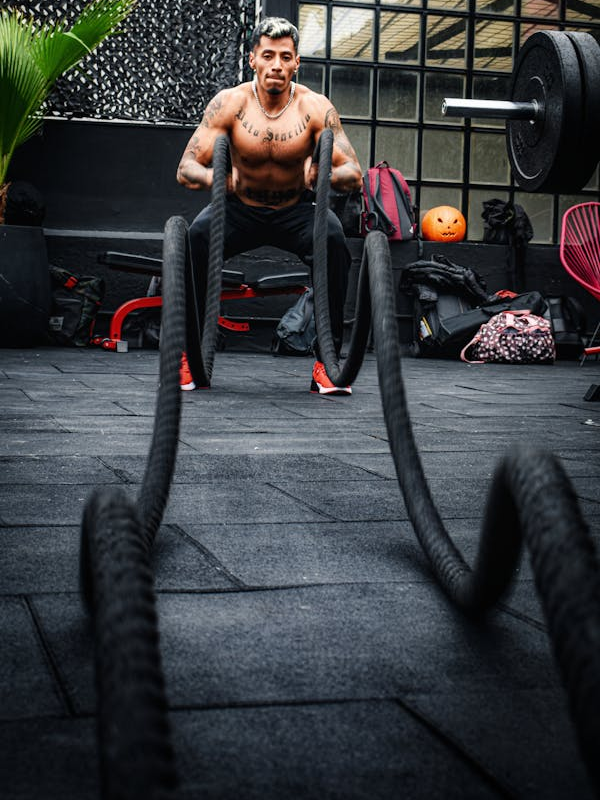Battle ropes have quickly become a popular and effective piece of fitness equipment in both commercial and home gyms, known for delivering a challenging workout that builds strength, endurance, and cardiovascular health. In our Ultimate Guide to Home Gym Equipment, we discuss various essential tools, but battle ropes stand out for their versatility and accessibility. This post will dive deep into the benefits, correct techniques, and tips to maximize your battle rope workouts, as well as compare them with other cardio options, helping you decide if they’re the perfect addition to your fitness routine.
What Are Battle Ropes?
Battle ropes are thick, durable ropes typically ranging from 30 to 50 feet in length and about 1.5 to 2 inches in diameter. They’re anchored to a stable point, and each end is held in one hand to perform a variety of dynamic movements, like waves, slams, and whips. Battle ropes are designed to work the entire body by combining resistance training with cardio, making them ideal for a full-body workout that builds both strength and endurance.

A Brief History of Battle Ropes
The use of ropes in physical training dates back centuries, but battle ropes as we know them today were popularized by John Brookfield, a strength and conditioning expert, in the early 2000s. Brookfield saw battle ropes as a way to develop functional strength and endurance without the need for traditional weights. Since then, they’ve become a mainstay in fitness routines, embraced by everyone from professional athletes to gym beginners.
The Role of Battle Ropes in Modern Fitness
Battle ropes are especially valued in modern fitness for their versatility and adaptability. They’re a low-impact workout tool, meaning they’re easy on the joints, which makes them suitable for all fitness levels. Additionally, battle ropes offer the flexibility to increase or decrease intensity, targeting different muscle groups depending on the movement. Whether you’re looking to boost cardio fitness, improve muscular endurance, or add variety to strength training, battle ropes can be a powerful addition to any workout.
The Benefits of Battle Rope Workouts
Incorporating battle ropes into your routine can bring a wide range of fitness benefits, making them a popular choice for full-body conditioning. Here’s how they can improve your cardio, strength, and endurance:
1. Cardiovascular Conditioning
Battle rope workouts offer an intense form of cardiovascular training that gets the heart pumping. With movements like alternating waves, slams, and whips, battle ropes engage large muscle groups, creating a high-energy workout that boosts your heart rate quickly. This aerobic challenge improves cardiovascular health, supports calorie burn, and can be adapted to various intensity levels, making it ideal for both beginners and advanced athletes.

2. Strength Building
Battle ropes are a form of resistance training that engages the upper body, core, and even the lower body, depending on the movement. Each exercise works muscles in the shoulders, arms, back, and core, helping to build muscular strength and endurance over time. Unlike traditional weights, battle ropes engage muscles in a dynamic and explosive way, improving not just strength but also coordination and control.
3. Endurance and Stamina
One of the standout benefits of battle ropes is the way they train muscular and cardiovascular endurance. Because the exercises can be repeated at high intensity for longer durations, battle ropes increase stamina and help the body become more resilient to fatigue. Over time, regular use can lead to improved muscle endurance, allowing you to sustain activity longer across all types of workouts.
4. Core Stability and Coordination
Each battle rope movement challenges your core stability, as maintaining balance and control throughout the exercises requires core engagement. Additionally, the combination of coordination and rhythm involved in battle rope exercises helps to develop balance and proprioception, which benefits daily movement and athletic performance.
5. Low Impact, High Reward
Battle ropes offer a low-impact workout, meaning they put less stress on your joints compared to exercises like running or jumping. This makes them accessible for people at different fitness levels, including those recovering from injury or looking for joint-friendly workouts. Despite being low impact, battle ropes deliver high rewards in terms of calorie burn, muscle engagement, and cardiovascular benefits.
How to Use Battle Ropes Correctly and Effectively
Using battle ropes effectively comes down to mastering the right form and technique. Good posture and controlled movement will not only help you get the most out of your workout but also reduce the risk of injury. Here’s how to set yourself up for success with battle ropes:
- Step 1: Start with your feet shoulder width apart
- Step 2: bend over slightly, bending your knees keeping your back straight
- Step 3:grip each end of the battle ropes tightly
- Step 4: for 30 seconds – 1 minute wave the ropes at a medium to high intensity

1. Start with Proper Posture
Begin each battle rope movement in a stable stance. Stand with your feet hip-width apart, and slightly bend your knees to create a balanced and athletic posture. Engage your core to protect your lower back, keep your chest upright, and relax your shoulders away from your ears. This posture will help you maintain control and stability throughout each exercise.
2. Grip the Ropes Correctly
Grip each rope handle firmly, with palms facing inward toward each other in a neutral position. Avoid squeezing too tightly; a firm but relaxed grip allows fluid motion and reduces strain on your wrists and forearms. For heavier ropes or higher intensity movements, you may need a tighter grip, but generally, try to keep your hands relaxed to focus more on the larger muscle groups in your arms and shoulders.
3. Use Controlled Movements
It’s tempting to focus on speed, but effective battle rope training is all about controlled movements. Each wave, slam, or circle should be deliberate and full-bodied. For example, in an alternating wave, your arms should create smooth, rhythmic motions without jerking or overextending. Controlled movements engage muscles more effectively, help build strength, and ensure you’re maximizing each repetition.
4. Breathe and Maintain a Rhythm
Breathing plays a key role in battle rope exercises. Inhale through your nose as you prepare, and exhale through your mouth as you complete each movement. Keeping a steady breathing rhythm not only helps you power through the workout but also makes it easier to maintain good form.
5. Avoid Common Mistakes
Some common mistakes to watch out for include arching your back, lifting your shoulders, and using only your arms. Keep your core engaged to avoid arching, relax your shoulders, and think of each movement as a full-body exercise. By engaging your core, legs, and shoulders, you’ll add more power to each motion and reduce unnecessary strain on smaller muscles.
6. Focus on Time, Not Just Reps
With battle ropes, you can structure your workout based on time intervals rather than just counting repetitions. Start with 20-30 seconds of active movement, followed by 10-20 seconds of rest, and gradually increase the active time as you build endurance. This method allows you to work at a pace that feels challenging without sacrificing form.
Top Battle Rope Exercises for a Full-Body Workout
Battle ropes offer a range of dynamic exercises that can target various muscle groups, build endurance, and boost cardiovascular fitness. Here are some of the most effective battle rope exercises, along with their specific benefits:
1. Alternating Waves
In alternating waves, you create a ripple effect by moving each arm up and down in an alternating rhythm. This exercise is excellent for improving shoulder endurance, strengthening your arms, and building core stability. By focusing on a steady rhythm, alternating waves help elevate your heart rate, making it a great cardio and conditioning workout.
How to Perform:
- Stand in an athletic stance with your feet hip-width apart and slightly bend your knees.
- Grip a rope in each hand, and move one arm up while bringing the other down, alternating quickly but with control.
- Keep your core engaged to maintain balance as you create smooth, rolling waves.
2. Double Arm Slams
Double arm slams involve lifting both arms overhead and slamming the ropes down with force. This movement targets your shoulders, back, core, and even your legs, as it requires power from the entire body. Double arm slams are great for building explosive strength, improving coordination, and burning calories.
How to Perform:
- Stand with your feet shoulder-width apart, knees slightly bent, and hold the ropes with an overhand grip.
- Lift both ropes overhead, then forcefully slam them to the ground while bending at the knees.
- Return to standing and repeat, maintaining a powerful, controlled motion with each slam.

3. Side-to-Side Waves
Side-to-side waves, also known as lateral waves, add a rotational element to the workout. This exercise challenges your core, obliques, shoulders, and arms, helping to improve lateral stability and coordination. It’s a good way to add variety to your battle rope routine and work different planes of motion.
How to Perform:
- Start with feet slightly wider than hip-width apart, holding each rope in a neutral grip.
- Engage your core and swing both ropes simultaneously from one side to the other, using your torso to guide the movement.
- Keep your arms slightly bent and controlled as you move side to side, creating waves that flow horizontally.
4. Battle Rope Whips
The whip motion involves bringing both arms together to create synchronized waves. This movement is effective for building upper body and core strength and is commonly used to improve endurance and coordination. Whips are also a highly efficient way to elevate your heart rate and build cardio fitness.
How to Perform:
- Stand in an athletic stance, holding the ropes in front of you.
- Move both arms up and down in unison, creating synchronized waves.
- Focus on keeping the motion steady and engaging your shoulders and core with each whip.

5. Battle Rope Circles
Battle rope circles are a unique movement that requires you to create circular motions with the ropes. This exercise targets the shoulders, biceps, and forearms and also engages the core to maintain stability. Circles help with shoulder mobility and can be performed in both inward and outward directions for variety.
How to Perform:
- Start in a comfortable stance, holding the ropes with an overhand grip.
- Create small circles with each hand, either inward or outward, maintaining control and rhythm.
- Keep your shoulders relaxed and core tight, focusing on smooth circular movements.
Tips and Tricks for Maximizing Your Battle Rope Workouts
Battle ropes are a versatile training tool, and with the right approach, they can deliver a highly effective workout for building strength, endurance, and cardiovascular fitness. Here are some practical tips to help you get the most out of your battle rope workouts:
1. Incorporate Intervals for Intensity
Battle ropes are ideal for interval training, which alternates periods of high-intensity effort with short recovery breaks. For example, try 30 seconds of intense exercise (like waves or slams) followed by 15–20 seconds of rest. This approach boosts calorie burn, builds endurance, and makes workouts more manageable, allowing you to maintain high energy and intensity levels without burning out too quickly.
2. Experiment with Different Movement Patterns
Switching up your battle rope movements keeps your workouts fresh and challenges various muscle groups. Alternating waves, double arm slams, and side-to-side waves all target different muscles, while movements like circles and whips add new dimensions to your routine. Varying your exercises also helps prevent muscle adaptation, ensuring you continue to make gains.
3. Adjust the Rope Length for Pacing and Resistance
The length of your battle ropes affects workout intensity. Moving closer to the anchor point shortens the ropes and creates less resistance, making exercises faster and more manageable. Standing farther back increases resistance, requiring more effort for each movement. By adjusting your position, you can tailor the difficulty level to your fitness needs and goals.
4. Combine Battle Ropes with Other Exercises
For a well-rounded workout, consider combining battle ropes with other exercises. Pairing them with bodyweight moves like squats, lunges, or push-ups creates a dynamic circuit that keeps your heart rate up and targets multiple muscle groups. This approach is great for both full-body conditioning and adding variety to your sessions.
5. Focus on Duration Rather Than Repetitions
Battle rope workouts are often more effective when performed for time rather than counting reps. Instead of focusing on the number of waves or slams, aim to complete each exercise for a set duration (e.g., 30 seconds to a minute). This helps build muscular endurance and allows you to concentrate on maintaining form and rhythm, rather than rushing through reps.
6. Control Your Breathing
Proper breathing is crucial for maintaining intensity and form during battle rope workouts. Inhale deeply through your nose to prepare and exhale forcefully through your mouth as you complete each movement. This rhythm can help you maintain power, improve endurance, and avoid fatigue.
7. Progress Gradually
If you’re new to battle ropes, start with shorter intervals and lighter intensity to build familiarity and strength. As you become more comfortable, gradually increase your work intervals or move farther from the anchor point to add resistance. Progression is key to improving without overworking your muscles or risking injury.
Battle Ropes vs. Skipping Ropes: Which Is Better for Cardio?
Both battle ropes and skipping ropes are excellent tools for cardio workouts, but they offer unique benefits and cater to different fitness goals. Let’s break down what each brings to the table to help you decide which one best suits your workout needs. For more information check out our guide to skipping ropes here.
1. Cardiovascular Benefits
- Battle Ropes: Battle ropes provide a high-intensity cardio workout that quickly elevates the heart rate. The combination of upper and lower body engagement makes for a powerful aerobic exercise that improves heart health and burns calories. Battle ropes are especially effective for interval training, allowing for bursts of high-intensity movements with short rest periods in between, which is ideal for building cardiovascular endurance.
- Skipping Ropes: Skipping ropes are well-known for delivering a consistent cardiovascular workout. Each jump engages the heart and lungs, steadily improving cardiovascular fitness. Skipping is also easier to adjust for continuous cardio sessions, as it involves a repetitive motion that can be maintained for extended periods with practice.

2. Muscle Engagement
- Battle Ropes: Unlike skipping ropes, battle ropes involve significant upper body strength, working the shoulders, arms, and back with each movement. They also engage the core and even the legs, depending on your stance and movement pattern. This full-body engagement helps improve muscle endurance and strength alongside cardio benefits.
- Skipping Ropes: Skipping primarily targets the lower body, especially the calves, quads, and glutes. While it engages the core for balance and stability, it doesn’t provide the upper-body workout that battle ropes offer. However, skipping is excellent for lower-body conditioning, agility, and coordination.
3. Coordination and Agility
- Battle Ropes: Working with battle ropes can improve coordination by training the arms and core to work together in rhythm. Movements like alternating waves, whips, and slams challenge the body’s stability and control, which can enhance coordination over time. However, because the movements are typically slower and controlled, battle ropes are not as focused on agility.
- Skipping Ropes: Skipping ropes are highly effective for building agility, footwork, and quickness. The rapid jumping motion improves balance, timing, and foot coordination, which can be beneficial for sports performance and overall functional fitness. Advanced skipping variations, like double-unders and criss-cross, further enhance agility and precision.
4. Portability and Convenience
- Battle Ropes: While battle ropes are effective, they require ample space and a secure anchor point, making them less portable. They’re best suited for home or gym setups where you have enough room to use them effectively.
- Skipping Ropes: Skipping ropes are compact, lightweight, and portable, making them easy to carry and use anywhere. Whether you’re indoors, outdoors, or traveling, a skipping rope can provide an on-the-go cardio option with minimal setup.
5. Impact on Joints
- Battle Ropes: Battle rope exercises are generally low-impact, putting minimal stress on the joints. This makes them accessible for people with joint concerns, as the dynamic movements offer intensity without harsh impact.
- Skipping Ropes: Skipping involves continuous jumping, which can place stress on the knees, ankles, and hips over time. While proper form and cushioned surfaces can reduce the impact, skipping may not be ideal for those with existing joint issues.
Which One Is Right for You?
- Choose Battle Ropes If: You’re looking for a full-body workout that combines cardio with strength training, or you want a low-impact option with intense cardio benefits. Battle ropes are ideal for interval workouts and for those who have access to a space where they can be anchored securely.
- Choose Skipping Ropes If: You need a portable, convenient cardio option that improves agility and lower-body endurance. Skipping ropes are perfect for quick, on-the-go cardio sessions and work well for those focused on footwork, speed, and coordination.
Who Can Benefit from Battle Ropes?
Battle ropes are a versatile piece of equipment that can fit into a variety of fitness routines, making them suitable for people at different fitness levels and with diverse goals. Here’s a breakdown of who can benefit most from incorporating battle ropes into their training:
Conclusion: Why Battle Ropes Should Be in Your Workout Routine
Battle ropes offer a unique blend of strength, endurance, and cardiovascular training that can elevate any workout routine. Whether you’re a beginner building foundational fitness, an athlete seeking explosive power, or simply looking for a way to keep workouts engaging, battle ropes provide a versatile and effective solution.
With their low-impact nature, battle ropes are accessible for those with joint concerns, yet challenging enough to benefit even the most experienced fitness enthusiasts. They promote full-body engagement, targeting multiple muscle groups and improving coordination, balance, and core stability. Plus, their adaptability makes them ideal for high-intensity interval training, strength conditioning, and everything in between.
Incorporating battle ropes into your routine can help you achieve a balanced approach to fitness, building both muscular strength and cardiovascular health in a dynamic and engaging way. So, if you’re looking for a workout tool that packs a punch, battle ropes may be the perfect addition to keep you motivated and moving toward your fitness goals.






One Comment
Comments are closed.